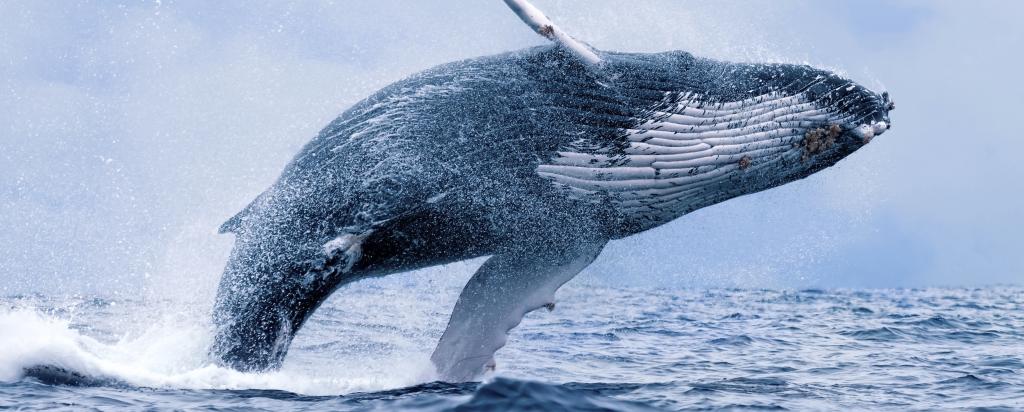
Published on the 17th June 2015 by ANSTO Staff
An important study is underway to determine the feeding ecology and migratory behaviour of the Southern Hemisphere Humpback Whale because of reported changes to the physical condition of the whales and their migratory feeding habits, according to ANSTO environmental scientist Debashish Mazumder, who is assisting investigator, Pascale Eisenmann of Griffith University.
Southern Hemisphere Humpback Whales, moderately large baleen whales, have some of the longest migration patterns for mammals on the planet; they journey from the Southern Pacific region to summer feeding grounds around Antarctica. In winter, the whales make their way to tropical breeding grounds off the eastern and western coasts of Australia.
Humpback Whales are often sighted in Southern Australian coastal waters in May and June during migration. They are known to fast for up to seven months during that period and feed on krill to replenish their blubber stores in Antarctic waters.
“Three significant signs have been reported relating to the feeding behaviour of Humpback Whales that are of concern,” said Eisenmann.
The first indication is that the number of stranded whales around the Southern Hemisphere has greatly increased during the past decade. Secondly, controversial findings reported by the Japanese scientific whaling research community suggest that the blubber thickness of Minke Whales has decreased by 10% over the past two decades and stomach content has decreased by 30%.
Humpback Whales consume the same food resources as Minke Whales. The third sign is an increase in reports of Southern Humpback Whales feeding along the migration route, indicating a change in behaviour.
In addition, if krill should decline in Antarctic waters, the whales are particularly at risk because feeding at this location has to support their own nutritional needs and those of their calves.
Eisenmann is undertaking the project with support from the Australian Institute of Nuclear Science and Engineering (AINSE) to characterise the migration and feeding ecology of the Southern Hemisphere Humpback Whale. ANSTO is contributing with radiocarbon analysis on baleen plates.
Baleen plates are composed of keratin and grow throughout the life of the individual whale; between 270-400 plates hang from the top jaw and act as filters for the krill. These plates reflect the nutrients absorbed through feeding.
Baleen plates are routinely collected opportunistically by the Southern Ocean Persistent Organic Pollutants Program (SOPOPP) and archives are maintained by SOPOPP, the Victoria Museum, the Australian Museum, the Queensland Museum and Murdoch University.
For this study, most samples were collected between 2009 and 2014, although the pool includes a sample from 1940. These plates are being analysed for both stable isotopes of carbon and nitrogen, and radiocarbon.
The use of stable isotope analysis of 13C and 15N from the baleen plates of numerous species of whales has been validated by marine researchers. The stable isotope analysis of samples was completed at the Isotope Ratio Mass Spectrometry facility at Griffith University.
The 14C analysis, which is taking place at ANSTO using accelerator mass spectrometry (AMS) by co-investigator of this research, Geraldine Jacobsen, is expected to provide an ‘additional tracer’ and complement the data acquired by stable isotope analysis.
Because of the natural and human variations of 14C in the world’s oceans, it can be used as a way to trace travelling bodies of water.
Since the whales travel through two different bodies of water, the Southern Ocean and the Pacific Ocean, variations in the amount of 14C are in the baleen plates are expected to relate to feeding locations.
“The Southern Ocean is one of the few places where there is an ‘old’ 14C signature, because of the upwelling of deep water that replaces surface water,” explained Mazumder. “The surface water there is low in14C compared to Australian surface waters.”
“We are measuring the 14C concentration from 18 samples taken from 5 baleen plates using the STAR accelerator. This will allow a comparison between a whale feeding according to the traditional model to a whale showing signs of supplementary feeding,“ explained Eisenmann.
“We value the opportunity to use non-lethal technologies to contribute to an understanding of nutritional ecology of Southern Hemisphere Humpback Whales. It is well-established, reliable approach to nutritional ecology research that we have undertaken on other organisms,” said Mazumder.
“Results from the bulk stable isotope analysis suggested unexpected individual variation in feeding ecology,” said Eisenmann. “Some whales seem to be feeding opportunistically during migration, while some are sticking to the classical model and fast the whole way. Very few seem to be feeding extensively along Australian waters.”
Co-investigators include Dr Susan Bengtson Nash and Professor Brian Fry from Griffith University, who are also studying the Antarctic sea ice ecosystem in other research.
The results of the stable isotope analysis are being prepared for publication and the radiocarbon data will be published separately.
The Humpback Whale is easily recognisable as it blows a cloud of vapour into the air when it breaks the surface to breathe. The name comes from a humped area of blubber behind the dorsal fin. Females can be up to 16 metres long.
Humpback Whales are one of the most exuberant species of whale and are known for their energetic behaviour including breaching, pectoral slaps and tail slapping. Male humpback whales often sing complex, lengthy and distinctive songs that are believed to communicate their presence to females.
Research suggests that nearly 95% of the population of Humpback Whales was eliminated by commercial whaling. The International Whaling Commission (IWC) declared an international moratorium on commercial whaling in order to protect large whales in 1986.
Learn more about whale watching in Australia.